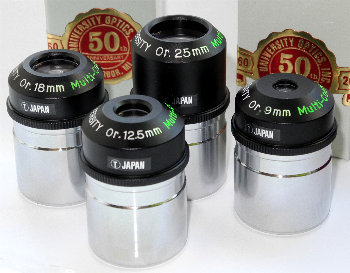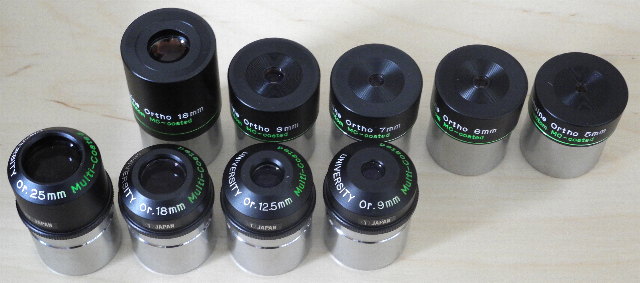In 1880 Ernst
Abbe patented the orthoscopic eyepiece for use with microscopes. For many years
these eyepieces were the acme of observing perfection and many older
astronomers will swear by them.
More recently the
Plossl along with budget wide-field eyepieces have become the eyepiece of
choice for most beginners and it seemed it was all over for the ortho now out
of fashion with few manufacturers and little interest among the new generation
of observers.
Recently its been
something of turnaround and a new generation of astronomers are finding
something to shout about in the traditional Abbe orthoscopic.......So what's
driving the recent comeback of this venerable design and just why are people
getting excited ?
Like
many people who started astronomy in the 1970s my scopes were always equipped
with less than perfect eyepieces. Ramsdens were very common along with Huygens
eyepieces. Anyone with memories that far back will swear how bad some of these
eyepieces were. Many looked like something out of a Christmas cracker and
performed about the same.
When I returned to the hobby
I was amazed at the range of eyepieces now available to even a modest purse
both in function and cost. Naturally, like many tyros I was seduced somewhat by
the charms of big heavy eyepieces with their huge field of views. 70 degrees,
80 degrees and even 100' field of view eyepieces from a variety of
manufacturers. Glossy adverts for budget wide-fields abounded and to the
beginner the large packaging of these eyepieces made them look a
bargain.
What quickly became apparent to me was that all but a few of
these wide-field eyepieces showed defects in either their sharpness or color
with some having distinctly 'muddy' views while others produced lot of false
color. What bothered me most was that the sharpness seemed to be missing in all
but the most expensive eyepieces.
Many beginners today start out with
the humble Plossl supplied with their telescopes. Like the Orthoscopic the
Plossl was once an expensive eyepiece technology and the preserve of the well
heeled. Unlike the orthoscopic Plossls lend themselves to mass production and
ever decreasing costs, and unfortunately, quality.
Low cost Plossls today are infinitely better than the dreadful
eyepieces of yore but very often there are very substandard ones in the market.
Orthoscopics by contrast are produced almost exclusively by small Japanese
companies who have their eye on quality.
 |
| Lens arrangement of an orthoscopic
eyepiece |
|
Orthoscopics are relatively inexpensive (at least compared to some
eyepieces) but to many new comers they look expensive for such a small piece of
glass.
The secret of an orthoscopic is the polishing of the glass.
A triplet lens arrangement must be
polished and cemented in a perfect arrangement if the eyepiece is to perform
well .
Unfortunately this costs and
there are only a few manufacturers who make the lenses and have sufficient
precision of assembly. |
|
When coupled with small
sales volumes the high precision induces a higher cost than a similar mass
produced Plossl.
Amazingly many of the orthoscopic eyepieces were made
by very small companies. The much venerated Tani was in fact one elderly man
who spent his life producing high quality eyepieces. These are the highly rated Circle T types. These were in production
for 60 years until 2012 when Tani-san retired.
Having tired of cheap wide-field eyepieces, and found high powered
Plossls to have short eye relief and, to my discredit, having scorned the use
of orthoscopics I found myself persuaded to the use of orthoscopics by an
astronomer friend. I asked what she used for her amazing sketches and she told
me she was using orthoscopics from University Optics. These were (since at the
time of writing Tani-san has retired) one of the main outlets for the Circle T
orthoscopics.
Biting the
bullet I decided to buy a pair of University Optics orthoscopics and see how I
got on. Knowing that I found high powered Plossls to be almost useless because
of their tight eye relief I opted for a pair in 9mm and 12mm. These were
ordered from the US and they were shipped very quickly. Orthos also have a
tight eyerelief but at lower powers are very
comfortable.
On arrival I was
somewhat surprised at the quality and feel. In photographs they tend to look a
bit plasticky but in the flesh they are quite weighty and solidly constructed
and have a very much old world charm about them.
 |
University Optics Volcano Tops.
50 years on and
still a great performer. |
|
I had been told that orthoscopics don't generally
tend to work well in faster scopes so my first nights viewing was using my f15
Maksutov. The eyepieces performed very creditably and indeed I would say they
were sharper than almost any other eyepiece in the scope. A later nights
viewing using an f5 reflector actually amazed me. The views were so sharp that
the only eyepiece that came close in contrast and sharpness was my 14mm Explore
Scientific which is a very much more expensive eyepiece
altogether.
Subsequent tests
showed I wasn't just seeing things and these relatively low cost orthoscopics
really were that sharp. On the basis of the initial viewing I acquired an 18mm
and 25mm for use with my Maksutov and also for use with my f10 achromat. In all
of the scopes the eyepieces have performed superbly. |
|
A few months
later I had the chance to acquire an almost full set of Baader Genuine Abbe
Orthos (BGOs) which are priced slightly higher than the University Optics
volcano topped Circle T's. Much has been written about the Baaders ability to
work a little better with less scatter due to their phantom coatings. Testing
like with like on focal lengths I found little difference. I suspect it may be
possible to see a difference with perfect seeing conditions or maybe better
eyesight just on the basis of other reviewers opinions. I could see no
discernible difference on a range of targets. I did though the Baader GOs to be less comfortable
to my eyes than the University Optics Volcano Top models. This is an endless
debate with astronomers and to my mind a profitless argument. Use what you find
comfortable is my opinion.
Build quality for
both the Baader and University Optics units were extremely good. Highly
polished and weighty chromed barrels and although the eyepiece tops are plastic
its a very high density and good quality with metal retaining rings and field
stops inside and well blackened interiors. The Baaders have smoothside barrels
whereas University Optics barrels have cut-outs. I would say the Baader GOs
were of very slightly better construction and slightly heavier but either would
be a good choice. In terms of value for money I consider the University Optics
Orthos to be amazing value.
As regards
quality of the views, much has been written. I could give you a list of targets
but its sufficient to say the best my f5 newt has ever performed outside of the
hallowed eyepieces from Pentax, Televue and Explore Scientific has been with
the University Optics and Baader Orthoscopics and I am not so sure that in
terms of sharpness, contrast and color rendition that they are really second to
much at all. Obviously like any orthoscopic they have a narrow field of view
and, at shorter focal lengths, tight eye relief but, in terms of contrast,
clarity and color rendition they can offer a performance which only the very
best eyepieces can match. Not bad for an eyepiece that cost £55
(University Optics) or £75 (Baader Genuine Ortho). You would have to
spend a lot more to get the same quality of view.
 |
My own collection of University
Optics and Baader orthoscopics.
On balance I prefer the
University Optics Volcano Tops for comfort. |
And so there you
are, an eyepiece that to many beginners often seems quaint and old fashioned
has started to see a rise in popularity again as the new generation of
observers finds that these eyepieces still have much to offer. Pin sharp views
for an extremely attractive price. For planetary, lunar and double star work
where field of view is not critical there is much that an orthoscopic can offer
but they can do so much more than that with their superb sharpness on deep sky
objects such as the Orion Nebula.
Sadly as I wrote this article it transpired that many orthoscopics
would no longer be available with the demise of some of the optical
manufacturers in Japan. This has been attributed both to the venerable Tan-san
retiring along with the Japanese Tsunami. Its sad that just as interest is
being revived in these classic eyepieces suppliers who have been producing them
for very many years ceased production. Baader are no longer producing the
Genuine Ortho and University Optics also are now also unable to supply the
classic Circle T Volcano Top.
New manufacturers are entering the
market however with Kasai restarting production of the HC series which are
similar to the Baader Genuine Orthos but without the much vaunted Phantom Multi
Coatings and Baader have released a budget Ortho series dubbed the BCO - so it
may not be last orders yet for this classic eyepiece
design.
|